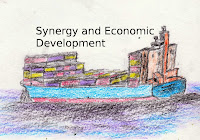In today’s world, international business is a
mainstay of everyday commerce and policy. Products move across the globe and make their
way into homes and lives of individuals and families at different places on the
planet. Most statistics include the hard goods and services that traverse
across borders but may be missing other tangible value. Dr. Predrag Bjelić
discusses the inclusion of direct foreign investment and labor flow as
important components of economic calculations.
Even though 2006 IMF data indicated that
75% of international trade is measured in goods the liberalization of trade has
also brought with it services, investment and human capital. The latter two being
something more difficult to concretely assess but should be included in the overall
assessment. Understanding the flow of information along with the intellectual capital
encourages a greater conception of global commerce and the antecedents to that
commerce.
Foreign Direct Investment (FDI) is an
important method of pushing up the employment economy. FDI can be defined as “an investment involving a long-term
relationship and reflecting a lasting interest and control by a resident entity
in one economy (investor or parent enterprise) in an enterprise resident in an
economy other than that of the investor (FDI enterprise or affiliate enterprise
or foreign affiliate)”(UNCTAD 2007, 245).
In the past, emerging markets grew from turning
investment income into productive output sold on the global market. To be
effective in this growth, human capital will also need to develop adequately to
use that investment capital to its maximum growth potential. Countries that
have excess labor skill inadvertently lose some of that labor skill to countries
that provide employment opportunities.
The author determines that multi-national companies
have changed traditional calculations of international commerce. In many cases
large firms provide direct foreign investment and emerging economies export
skilled labor in a type of loose exchange. New calculations should take into
account the flow of investment and the movement of labor across the borders to
get a better perspective of global exchange.
UNCTAD.
2007.
World Investment Report 2007:Transnational Corporations, Extractive Industries
and Development. Geneva.
Bjelic, P. (2013). New approach in international trade
analysis due to international factor movements. Zbornik Radova Ekonomskog Fakulteta
u Istocnom Sarajevu, 7
